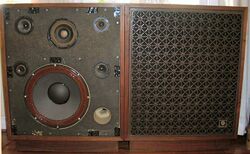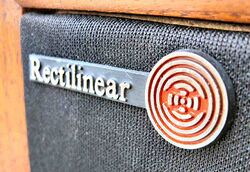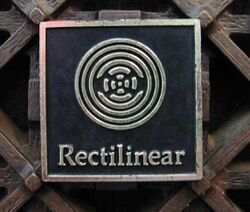Company:Rectilinear Research Corporation
| Industry | Loudspeaker manufacturers |
|---|---|
| Founded | 1966 (est.) |
| Founder | Morris I. Wiener |
| Defunct | 1977-8 |
| Headquarters | Brooklyn and Bronx, New York |
Key people | Arnold Schwartz, James Bongiorno, Marty Gersten, Jon Dahlquist, Richard Shahinian |
| Products | Loudspeaker |
Rectilinear Research Corporation was a manufacturer of loudspeakers. The company was formed around 1966 and its principal was Morris I. Wiener (alt. sp. "Weiner") of Plandome Manor, New York.[1]
The first known main office location for the company (1966–68) was at 30 Main Street, Brooklyn, New York.[2] Some time around 1968, the company moved headquarters, manufacturing assembly, and service center to 107 Bruckner Blvd (E 133rd St.) in the Bronx.[3] The company remained at this address until it was shuttered in 1977–8.[4][5][6]
Arnold Schwartz (Micro-Acoustics, founded in 1966[7]), James Bongiorno (Ampzilla, founded in 1974[8]), Marty Gersten (Ohm Acoustics, founded 1971[9]), Jon Dahlquist (co-founder [with Saul B. Marantz] of Dahlquist Phased Array in 1978 [10]), and Richard Shahinian (later engineer designer with Harman Kardon[11] and founder of Shahinian Acoustics [12] at or around 1975) were at different times and at different stages working with the company as engineers to develop speaker models.[13][14][15]
The company launched its first model, the Rectilinear III, in 1966.[16] The early versions were designed by Arnold Schwartz and later by James Bongiorno (who also designed the Rectilinear X model).[17]
The first known independent notice for the "III" is a retailer advertisement dated 12/4/1966.[18] This model, as did many later Rectilinear models, received many positive reviews by audio journalists in major audio magazines, including Stereo Review, Popular Electronics, Buyer's Guide Magazine, and Stereo & Hi-Fi Times.[19][20][21][22][23] Three of the company's print advertisements were illustrated by the artist Rick Meyerowitz and ran in publications such as Rolling Stone, National Lampoon, and others in 1973 and 1974.[24][25][26]
Although formally this model always carried the name "III", it was colloquially often nicknamed the "Highboy" following the launch of the "III Lowboy" (around 1970) in order not to confuse the two models.[27] Both the III "Highboy" and III Lowboy are pictured here.
"One of the most natural sounding speakers I have ever used..."
"Our side-by-side comparison with a full range electrostatic speaker (Quad), which we consider to be one of the finest reproducers available, proved to our satisfaction that the two could not be told apart except in the low bass, where the Rectilinear III was clearly superior."
"We have never heard better sound reproduction in our home, from any speaker of any size or price."
"The sound of the Rectilinear III was almost perfectly neutral. It had absolutely no hollow or boomy quality on male voices and possessed the light, open, airy character that we always liked in a speaker".
Julian Hirsch, Stereo Review, Dec. 1967[28]
Ronald M. Benrey, Popular Science Monthly, May 1968[29]
Duke Ellington, in letter to the company dated 4 November 1966[16]
By 1971, Rectilinear had expanded its product range to include the following speaker models (MSRP prices per speaker):[30]
- III (3-way, six drivers) - 35x18x12" - $279
- III Lowboy (3-way, six drivers) - 28x22x12" - $299
- Mini III (3-way) - 19x12x10" - $100
- VI (3-way, six drivers) - 25x14x11" - $239 (discontinued by 1971)[31]
- Xa (3-way) - 25x14x11" - $199
- XI (2-way) - 23x12x11" - $80
- XII (3-way) - 25x14x11" - $139
Some of these early 3-way models featured 10" and 12" woofers manufactured by Jensen ("Flex-Air") and CTS (Chicago Telephone Supply), 5" whizzer cone squawkers manufactured by Philips Electronics of the Netherlands, and 2" and 2.5" cone tweeters by Peerless of Denmark.[32] The Rectilinear speakers were typically, but not always, of ported design and finished in walnut with fabric or fretwork grilles. Many models featured one, or sometimes two, rear tone controls. The company offered some of their models as kits and "semi-kits".[33]
Later models (1971 - approx. 1977) include:[34]
- 2
- 4
- 4.5
- 5
- 7 (high output fuse version "MTH 4" also available)
- 7A
- IIIa
- IIIb
- X
- XIa
- XIb
The company also produced a tilted speaker stand, the "Rectilinear Dispersion Base", intended to be used with the Model 5 speaker.[35]
Although the Rectilinear speakers were distributed through a nationwide network of up to 400 dealers, most of their sales was generated on the East Coast.[36] Distributor in Canada was H Roy Gray Ltd., 14 Laidlaw Blvd., Markham, Ontario.[37] International and military sales were offered by Royal Sound Co., 409 North Main St., Freeport, New York.[38]
References
- ↑ United States patents, 3913877, Wiener, October 21, 1975.
- ↑ Advertisement for model III.
- ↑ Advertisement with address listed.
- ↑ Legal Notice for creditors New York Times, December 28, 1977. p. 32
- ↑ Legal Notice for creditors New York Times, April 13, 1978. p. B15
- ↑ Legal Notice about sale of company assets New York Times, January 3, 1978. p. 56
- ↑ Micro-Acoustics Corp.
- ↑ History of Ampzilla
- ↑ Wikipedia article "Lincoln Wash"
- ↑ Wikipedia Germany article "Lautsprecher"
- ↑ Article in Stereophile Magazine, July 2004
- ↑ Shahinian Acoustics
- ↑ WRFM-FM, New York (now WWPR-FM) February 15, 1968.
- ↑ Interview with James Bongiorno at TNT Audio.
- ↑ Audiophile Magazine., July 1992
- ↑ 16.0 16.1 Advertisement with Duke Ellington endorsement.
- ↑ SAE Talk.[|permanent dead link|dead link}}], Yahoo Groups, 11/21/2001
- ↑ Classified ad for the model III New York Times, Dec 4, 1966. p. S20
- ↑ Review of model III Lowboy.
- ↑ Review of model 5.
- ↑ Review of model III Lowboy.
- ↑ Review of model III, 8/1968.
- ↑ Review of model Mini-III.
- ↑ Advertisement for model 5, 1973.
- ↑ Advertisement for 1974 lineup.
- ↑ Advertisement for model III, 1974.
- ↑ Driver Parts List. 1976.
- ↑ Review of model III
- ↑ Review of model III
- ↑ Advertisement with 1971 line-up.
- ↑ Advertisement for models III and VI.
- ↑ EIA codes.
- ↑ Advertisement for model III.
- ↑ Driver parts list, 1977
- ↑ Owner's Manual for Model 5.
- ↑ Advertisement with dealers listed.
- ↑ Advertisement with Canadian distributor listed.
- ↑ Advertisement with overseas and military distributor listed.
External links
- Database for Rectilinear literature
- Photo database for Rectilinear loudspeakers
- Known models and data (work in progress)
- Driver Interchangeability
 |





